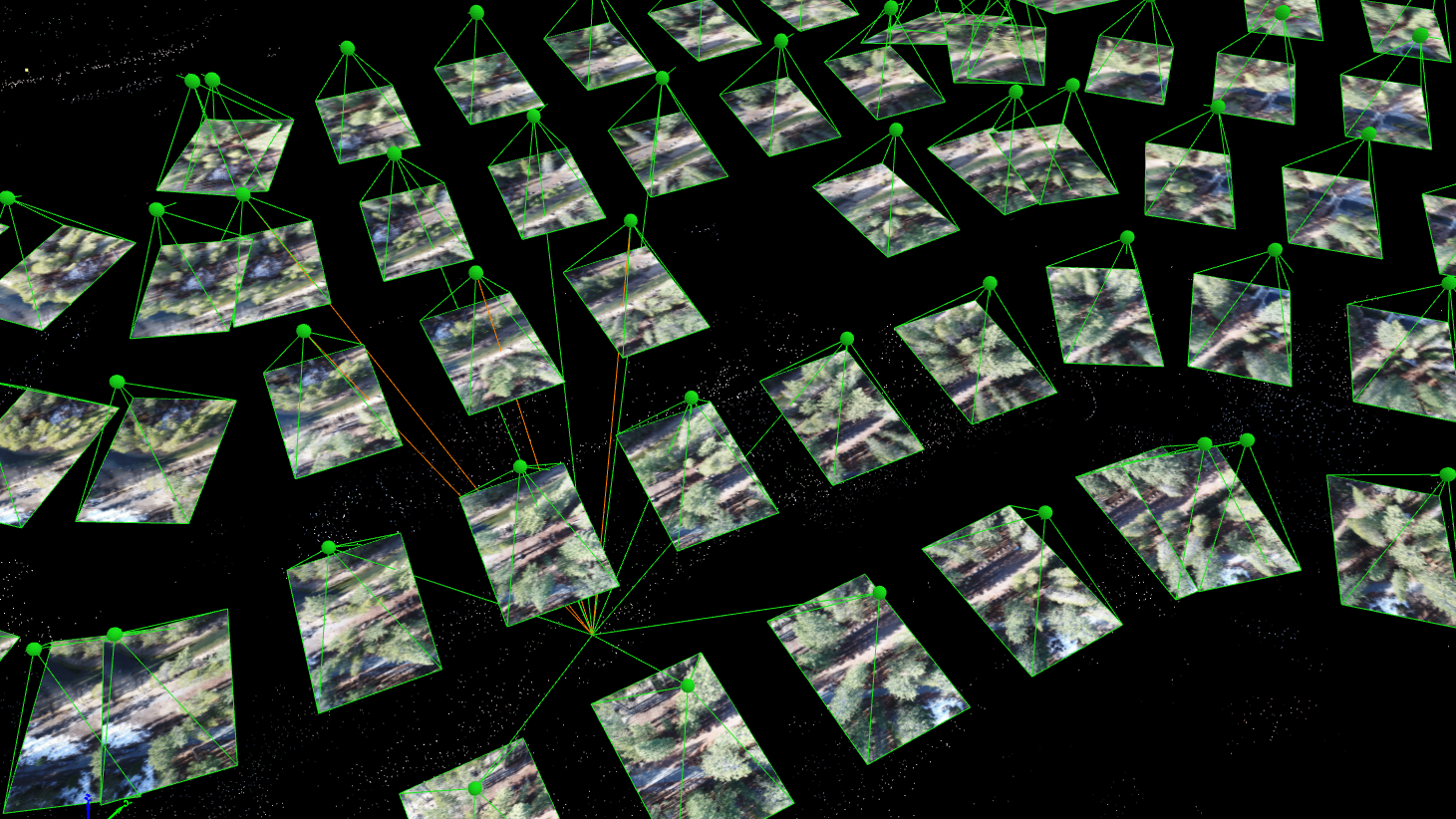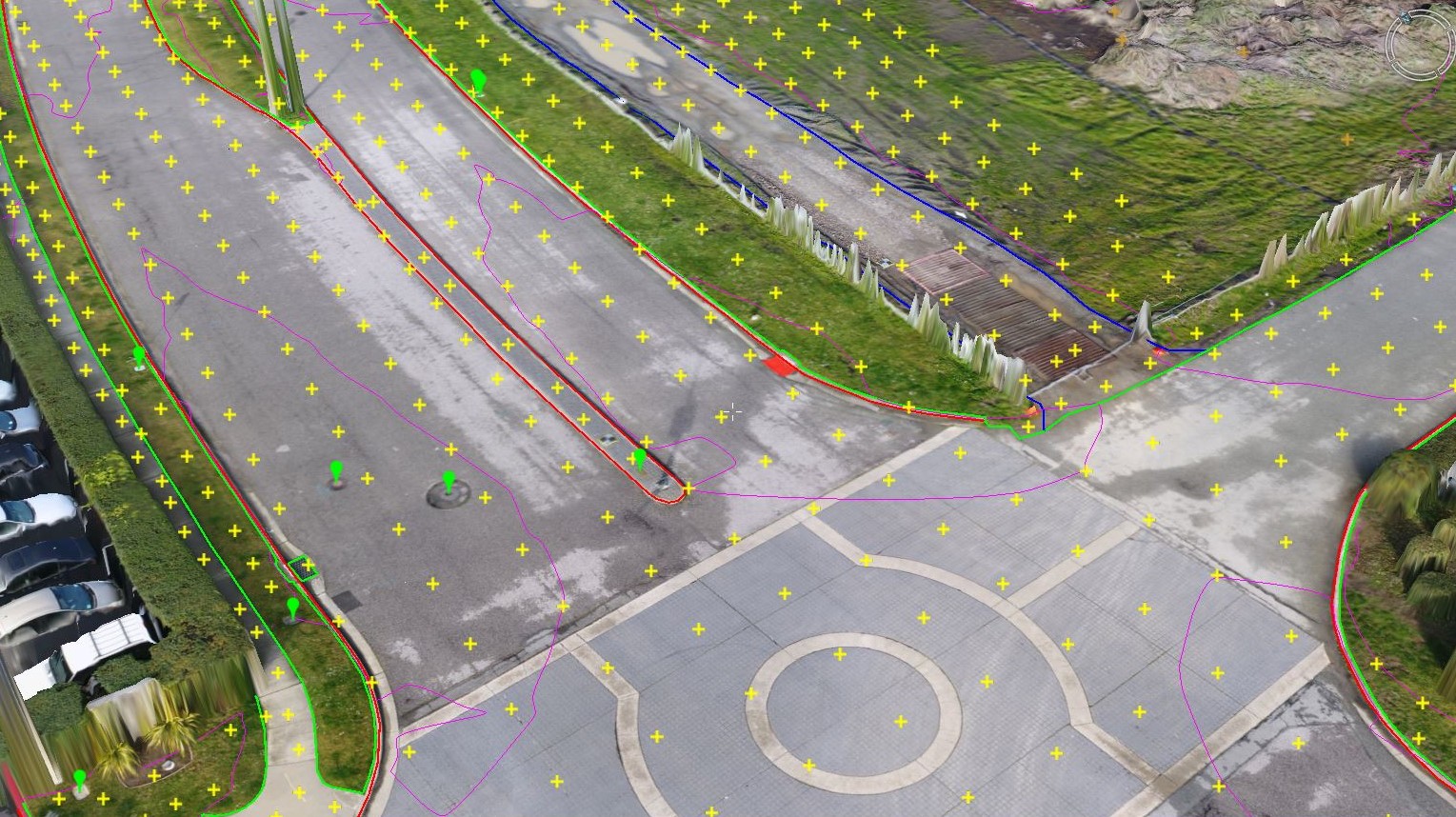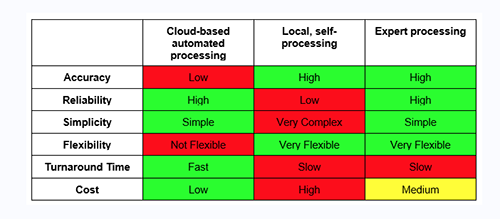The concept of data being the new oil isn’t a new one, but it recently made waves in the drone space because so many professional have come to realize how much data can be gathered in a safe, reliable, and cost-effective manner. Surveyors in particular have come to understand that they can do more with less by using drones, but doing so is dependent on being able to efficiently process the data being gathered. After all, gathering all the necessary data might take a single drone flight, but processing that data to create actionable information is a much different endeavor.
“Who should process your UAV mapping data?” is a question that many are asking, and the Aerotas team has put together a great resource to help professionals answer it. When it comes to processing, the options essentially come down to cloud-based automated processing, local self-processing and expert processing. What are the pros and cons of each approach though? What factors need to be taken into consideration when making a decision around which to choose? Their article breaks down the essentials of each approach, and provides indispensable insight for anyone trying to figure out the right drone data processing method for their company.We wanted to explore a few of the concepts from the article a bit more in-depth, so we caught up with Aerotas founder Logan Campbell. In the interview below, he lays out how much of a factor time is for processing, what cost distinctions exist for the higher-end processing options, where he recommends professionals start when they need to make a data processing decision and much more. Jeremiah Karpowicz: You mentioned that the best way to process data depends on the needs of each individual company. There’s no better way to put it, but how many of the challenges that organizations run into with data are on account of not thinking this way? Are too many users looking for and expecting to find an “easy” data button? Logan Campbell: It is definitely true that too many users are expecting there to be a single “easy” button to process data into exactly what they want. However, that simply is impossible.There are so many different types of surveys that can be completed with a drone, and they are very different. A topographic map of a real estate subdivision will require a very different workflow than a 3D reconstruction of a historical building facade. What might be an easy button on one project will be a processing nightmare for the other.Companies need to think critically about each project individually, and determine which processing solution best fits that need. The speed and simplicity benefits associated with cloud-based automated processing are very enticing to organizations. However, prioritizing those benefits can create situations where users don’t have the accuracy they actually need. What kind of challenges do users run into when this sort of thing happens?In drone data processing, there is a trade off between simplicity and accuracy.Automated, cloud based solutions such as DroneDeploy are very fast and very simple, but lack the accuracy and customization that comes with more manual processing. A lot of problems or errors that would be caught in manual processing might slip through the cracks in cloud based solutions, so it’s important to be very careful.Our clients weren’t happy with all of these trade offs, so we developed expert processing that combines the best of everything. In general, if high accuracy matters, then manual or expert processing will make the most sense. How does not getting the kind of accuracy needed the first time around impact the bottom line? Because if someone has to go back and redo something, it’s not just about the actual costs of doing so, is it? The silent killer throughout all of drone data processing is time. The promise of drones is that they will save an enormous amount of time. But just a few mistakes in accuracy, processing, or having to revisit a project site will counter all of those time savings, make you look bad in front of a client, and cost money. A single error in final accuracy might delay a project by a whole day or more.Having the expertise to prevent errors before they happen, and catch any errors in a timely manner is the best way to save money. This is why expert processing is the best choice for a lot of companies. When it comes to local, self-processing, how often do you run into users who don’t know what they don’t know? That is to say, someone thinks they know what they’re getting into when taking full control of their drone data processing, but find out the reality doesn’t line up with their expectation. This happens all the time. Software has made it so easy to produce a visually striking, beautiful 3D model. Anyone can do that. However, it is difficult to truly understand the difference between a good-looking model and an accurate model.Most people don’t realize that there is an enormous amount of work and science that goes into verifying the accuracy of drone data. The best way to learn more would be to check out ASPRS Positional Accuracy Standards. I personally am certified by the ASPRS as a Certified Mapping Scientist in UAS, which demonstrates the dedication we have towards high quality processing. What kind of bottlenecks can be created with self-processing? What kind of impact can this have on the bottom line for a project?Processing drone data requires really powerful, specialized computers. And even with this specialized hardware, the data processing will eat up 100% of that computer’s processing capability for hours at the minimum, and days for bigger projects. We have seen often people who think they can process drone data in the background of their computer, only to realize that there simply isn’t enough processing power for everything they want to do, either delaying critical CAD work, or the drone data processing. As usual, this means more time delays, and costs more money.Also, processing takes a lot of time from skilled employees. It can take hours of working with a project to get the final accuracy numbers right, even with a lot of computing resources. That is time that could be spent on other valuable client deliverables.
How does not getting the kind of accuracy needed the first time around impact the bottom line? Because if someone has to go back and redo something, it’s not just about the actual costs of doing so, is it? The silent killer throughout all of drone data processing is time. The promise of drones is that they will save an enormous amount of time. But just a few mistakes in accuracy, processing, or having to revisit a project site will counter all of those time savings, make you look bad in front of a client, and cost money. A single error in final accuracy might delay a project by a whole day or more.Having the expertise to prevent errors before they happen, and catch any errors in a timely manner is the best way to save money. This is why expert processing is the best choice for a lot of companies. When it comes to local, self-processing, how often do you run into users who don’t know what they don’t know? That is to say, someone thinks they know what they’re getting into when taking full control of their drone data processing, but find out the reality doesn’t line up with their expectation. This happens all the time. Software has made it so easy to produce a visually striking, beautiful 3D model. Anyone can do that. However, it is difficult to truly understand the difference between a good-looking model and an accurate model.Most people don’t realize that there is an enormous amount of work and science that goes into verifying the accuracy of drone data. The best way to learn more would be to check out ASPRS Positional Accuracy Standards. I personally am certified by the ASPRS as a Certified Mapping Scientist in UAS, which demonstrates the dedication we have towards high quality processing. What kind of bottlenecks can be created with self-processing? What kind of impact can this have on the bottom line for a project?Processing drone data requires really powerful, specialized computers. And even with this specialized hardware, the data processing will eat up 100% of that computer’s processing capability for hours at the minimum, and days for bigger projects. We have seen often people who think they can process drone data in the background of their computer, only to realize that there simply isn’t enough processing power for everything they want to do, either delaying critical CAD work, or the drone data processing. As usual, this means more time delays, and costs more money.Also, processing takes a lot of time from skilled employees. It can take hours of working with a project to get the final accuracy numbers right, even with a lot of computing resources. That is time that could be spent on other valuable client deliverables.  Accuracy and reliability are the essential benefits associated with expert processing, but the key drawback for this approach is associated with the amount of time it takes. How much of a time difference are we really talking about though?Usually about a day or less. That comes from the extra time it takes to upload data to the cloud, and then for the experts to setup, process, run QA/QC checks on the results, and make any changes necessary. While 24 hours may be too long for some use cases like emergency response, in most cases, that extra time is worth the extra accuracy and reliability. Your pricing chart calls out the costs associated with local processing as “high” and expert processing being “medium”, but I would have expected these costs to be the same, or even for the expert processing to be higher. Can you briefly talk about the cost considerations for each approach?Economies of scale means that expert processing can actually be cheaper than self processing. Expert processors will have tens of thousands of dollars in specialized computer hardware, but will have it running 100% of the time.Also, what might take an amateur a few days of work, would only take an expert an hour or two. This level of specialization and utilization means that you can often get better data for less money. That is why at Aerotas we are able to offer our expert processing services at prices that are often lower than self-processing. What advice would you have for someone who is trying to figure out what process is going to work best for them, but are having trouble making a decision even after weighing out the pros and cons of each approach?Start with the easiest way to get high accuracy and then see what is right for you. The biggest mistake is spending thousands of dollars on specialized hardware, software, and training only to discover that isn’t the right workflow for you. Cloud based and expert processing is usually billed on a per-month or per-project basis, keeping up front costs down. See if those are right for you, and you can always buy the expensive stuff later.
Accuracy and reliability are the essential benefits associated with expert processing, but the key drawback for this approach is associated with the amount of time it takes. How much of a time difference are we really talking about though?Usually about a day or less. That comes from the extra time it takes to upload data to the cloud, and then for the experts to setup, process, run QA/QC checks on the results, and make any changes necessary. While 24 hours may be too long for some use cases like emergency response, in most cases, that extra time is worth the extra accuracy and reliability. Your pricing chart calls out the costs associated with local processing as “high” and expert processing being “medium”, but I would have expected these costs to be the same, or even for the expert processing to be higher. Can you briefly talk about the cost considerations for each approach?Economies of scale means that expert processing can actually be cheaper than self processing. Expert processors will have tens of thousands of dollars in specialized computer hardware, but will have it running 100% of the time.Also, what might take an amateur a few days of work, would only take an expert an hour or two. This level of specialization and utilization means that you can often get better data for less money. That is why at Aerotas we are able to offer our expert processing services at prices that are often lower than self-processing. What advice would you have for someone who is trying to figure out what process is going to work best for them, but are having trouble making a decision even after weighing out the pros and cons of each approach?Start with the easiest way to get high accuracy and then see what is right for you. The biggest mistake is spending thousands of dollars on specialized hardware, software, and training only to discover that isn’t the right workflow for you. Cloud based and expert processing is usually billed on a per-month or per-project basis, keeping up front costs down. See if those are right for you, and you can always buy the expensive stuff later. 















Comments